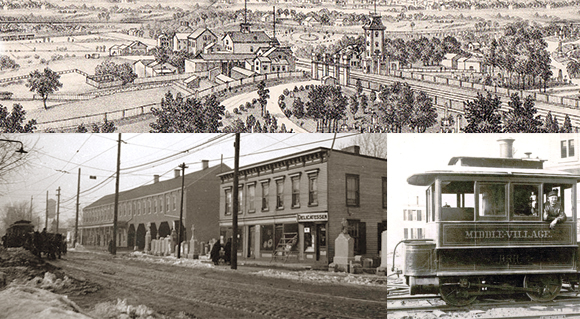The neighborhood we know today as Middle Village would likely not exist had it not been for the towns of Williamsburgh in Kings County and Jamaica in Queens County in the early 19th century. Jamaica was a well-settled farming town and Williamsburgh was where the ferry to Manhattan was located. Long Island and Jamaican farmers hauled their goods via horse and wagon to the Brooklyn ferry dock, where they would cross the river to travel to Manhattan markets. Meanwhile, “public transportation” to Manhattan at the time consisted of stagecoaches to the ferry. The streets were dirt roads, and not easily navigable.
The origins of Middle Village
In the early years of the 19th century, the land lying between “The Road to Fresh Ponds” (Fresh Pond Road) and the “Road to Dry Harbor” (80th Street) was simply considered part of Newtown Township, a scattered settlement consisting mostly of English farmers. Its best known landmark was the gigantic peat bog known as Juniper Swamp.
In 1813, plans were drawn up by the Williamsburg and Jamaica Turnpike Road Company, incorporated by brothers Stephen and Samuel Masters, to build a road along an old Indian path and later colonial route that led through the area from Jamaica to the East River. Much of the road’s route, however, was newly created. The Williamsburgh-Jamaica Turnpike, built of wooden planks, was completed over the course of 2 years, and officially opened in 1816 as a private toll road. A toll booth was known to have existed where the road crossed Flushing Avenue.
Public improvements tend to spur real estate transactions, and many saw opportunity in this newly constructed road. A small hamlet grew along the turnpike and came to be known as “Middle Village” as it was roughly halfway between Jamaica and the Brooklyn docks. Restaurants, inns, stores and blacksmiths opened to cater to travelers along the turnpike.
In the 1840s, German immigration to the U.S. reached a fever pitch, and many settled in Middle Village and surrounding towns. The population of the town boomed. In 1852, Lutheran Cemetery opened and brought on a slate of new businesses – funeral homes, monument works and florists.
A toll road no longer
The Masters brothers relinquished their operation of the Williamsburgh and Jamaica Turnpike in 1834, but their company continued to operate the toll road and improved it in 1849, but by the close of the Civil War, the road was in rough shape.
In 1869, the Williamsburg and Jamaica Turnpike Road Company authorized the North Second Street and Middle Village Railroad to construct tracks and run a trolley along the road between Williamsburgh and Lutheran Cemetery.
On June 2, 1873 James A. Herriman, who was president of the company, sold the turnpike to the Township of Newtown for $15,000 in bonds. The now public road then became exclusively referred to as Metropolitan Avenue.
St. John Cemetery was founded in 1879. The trolley tracks were extended to St. John in 1881. Fresh Pond Crematory opened in 1884, further bolstering the town’s funerary reputation.
Let there be light!
In 1892, a plant in East Williamsburgh (Ridgewood) was built to supply power to electric arc street lights that were installed along Metropolitan Avenue between Dry Harbor Road (today 80th Street) and the Brooklyn county line. These dim lights proved to only be a temporary measure.
Gas mains were soon laid along Metropolitan Avenue and 95 gas lamps were installed in 1895 to replace the electric arc street lamps. These lights required that an individual carry a ladder to each lamp at dusk and light and return at dawn and extinguish it.
In 1923 a substation was constructed in Maspeth to supply electricity to the entirety of what is now the Community Board 5 Queens area: Maspeth, Middle Village, Ridgewood and Glendale.
JPCA Forms Bicentennial Committee
The Juniper Park Civic Association and the Newtown Historical Society are planning events throughout the year to celebrate the bicentennial. More about the history of Middle Village will be included in the next issue of the Juniper Berry. We hope that you will join the celebration.
More information will be presented at our Town Meeting on Thursday, March 3rd (7:45pm) at Our Lady of Hope Auditorium.



